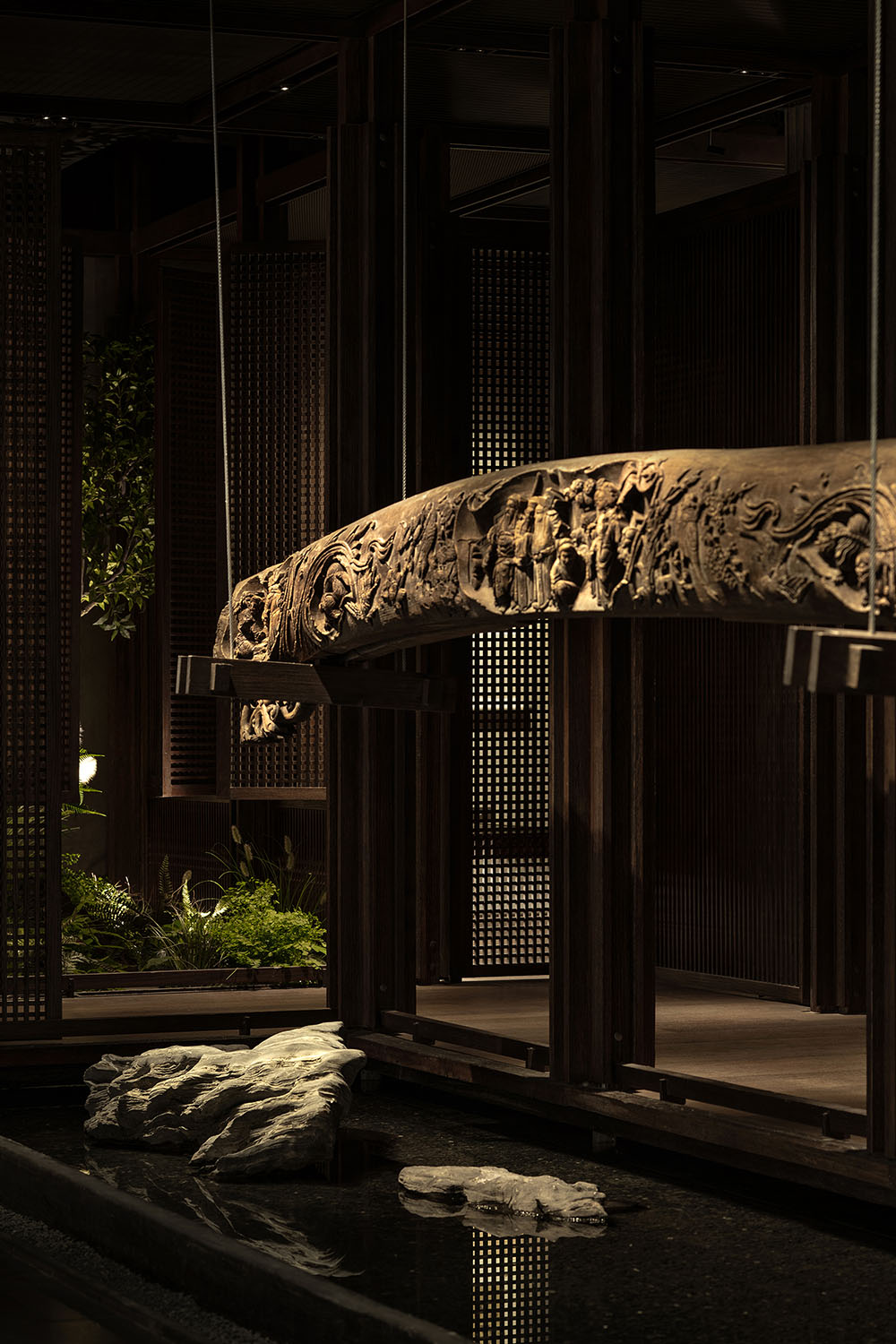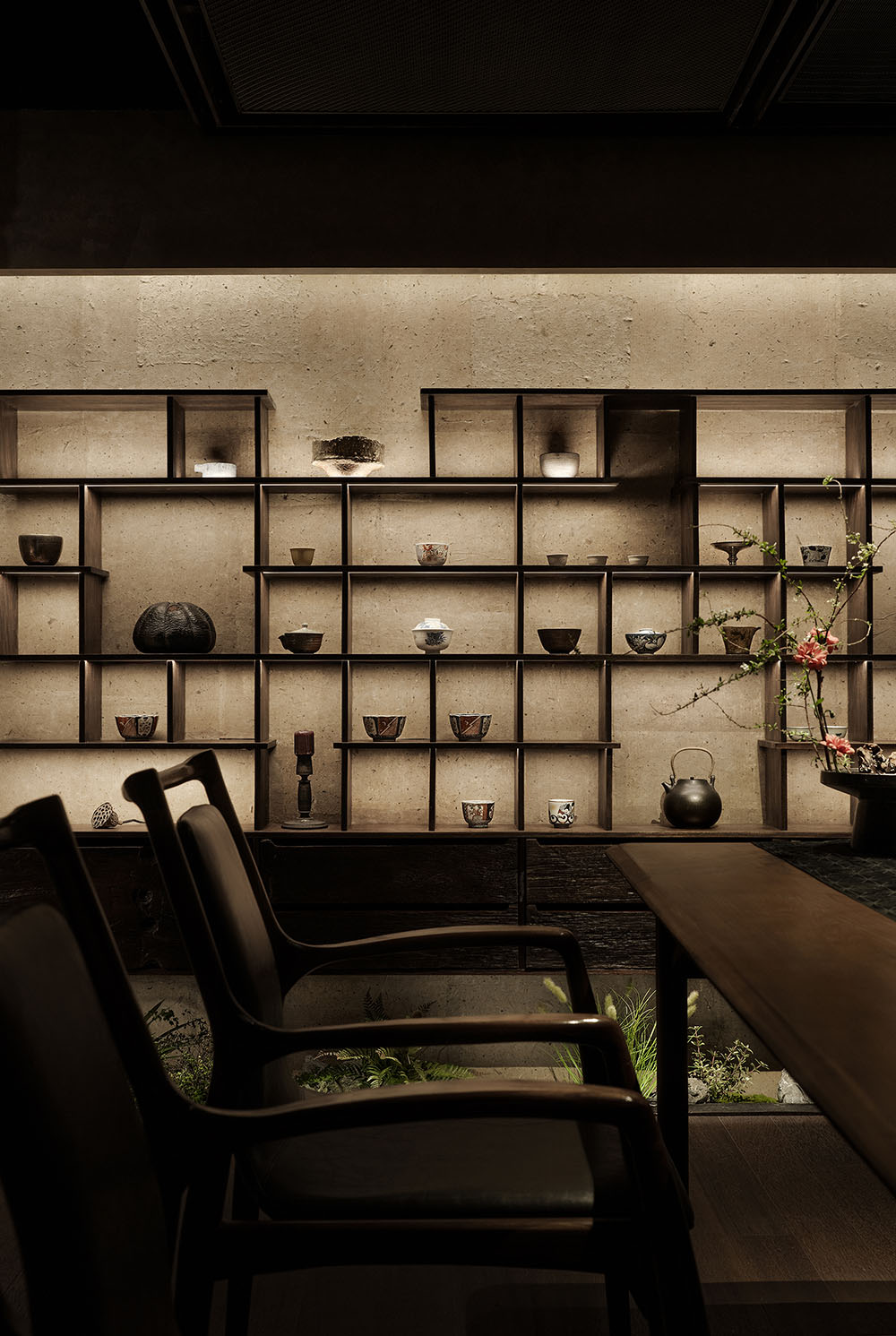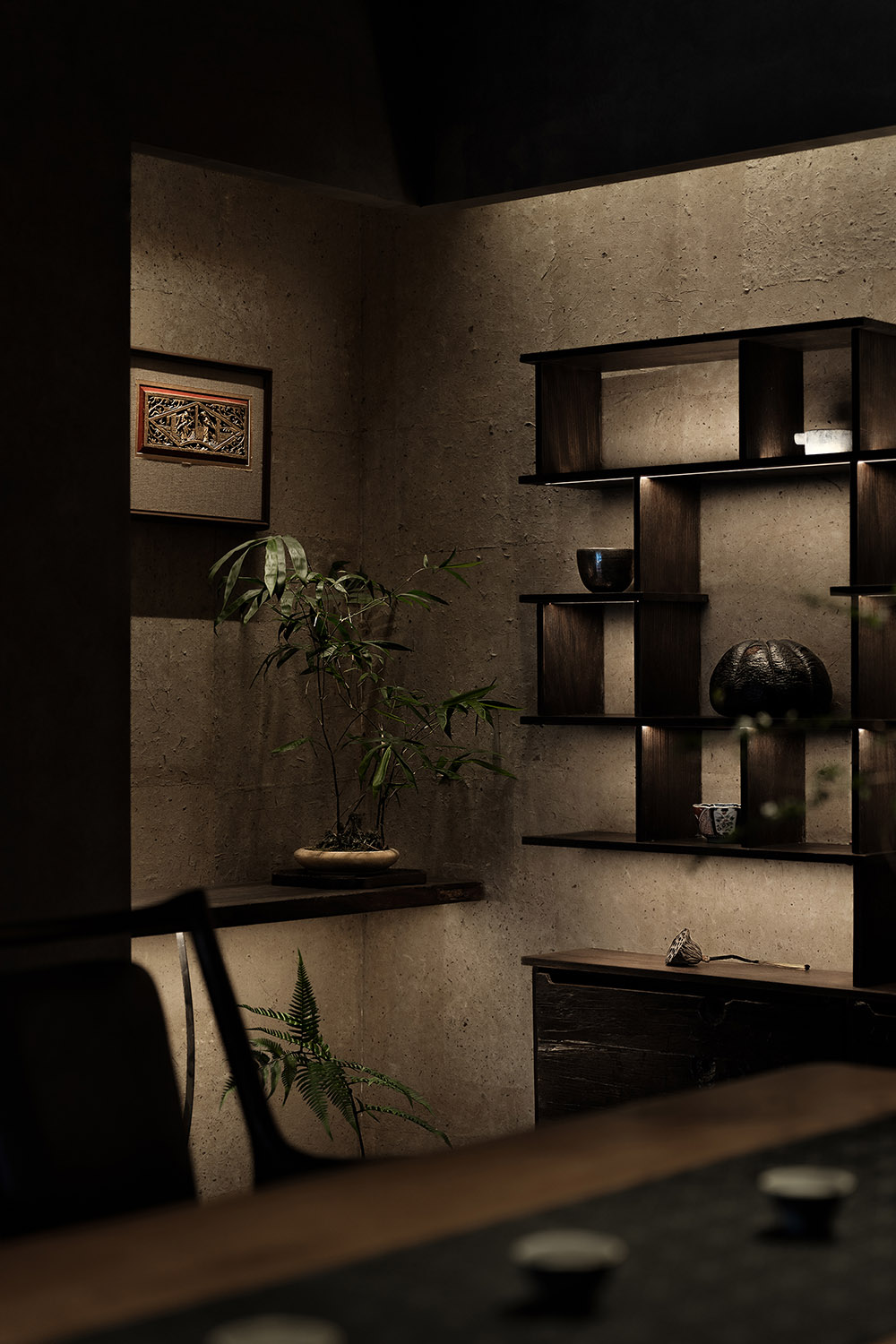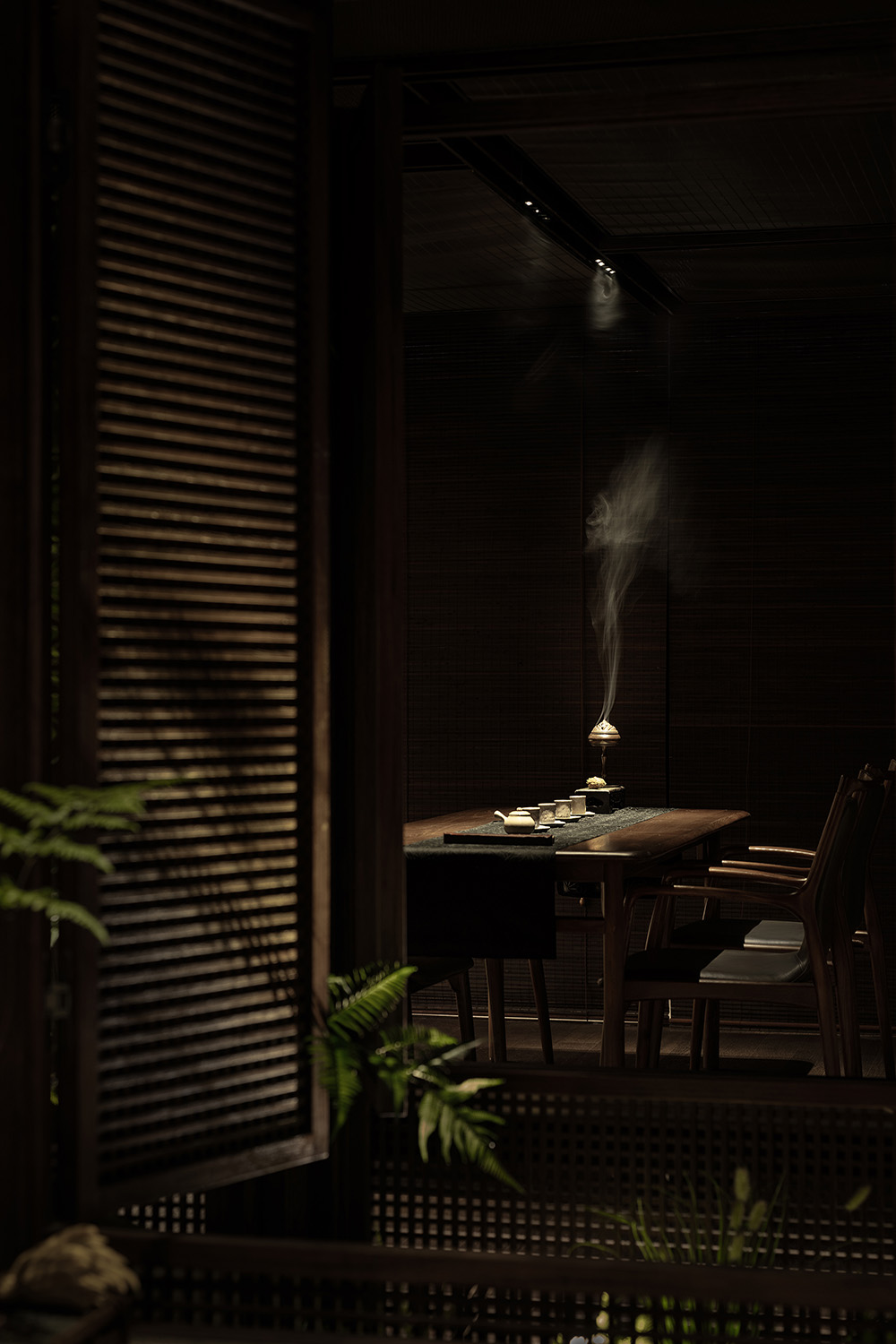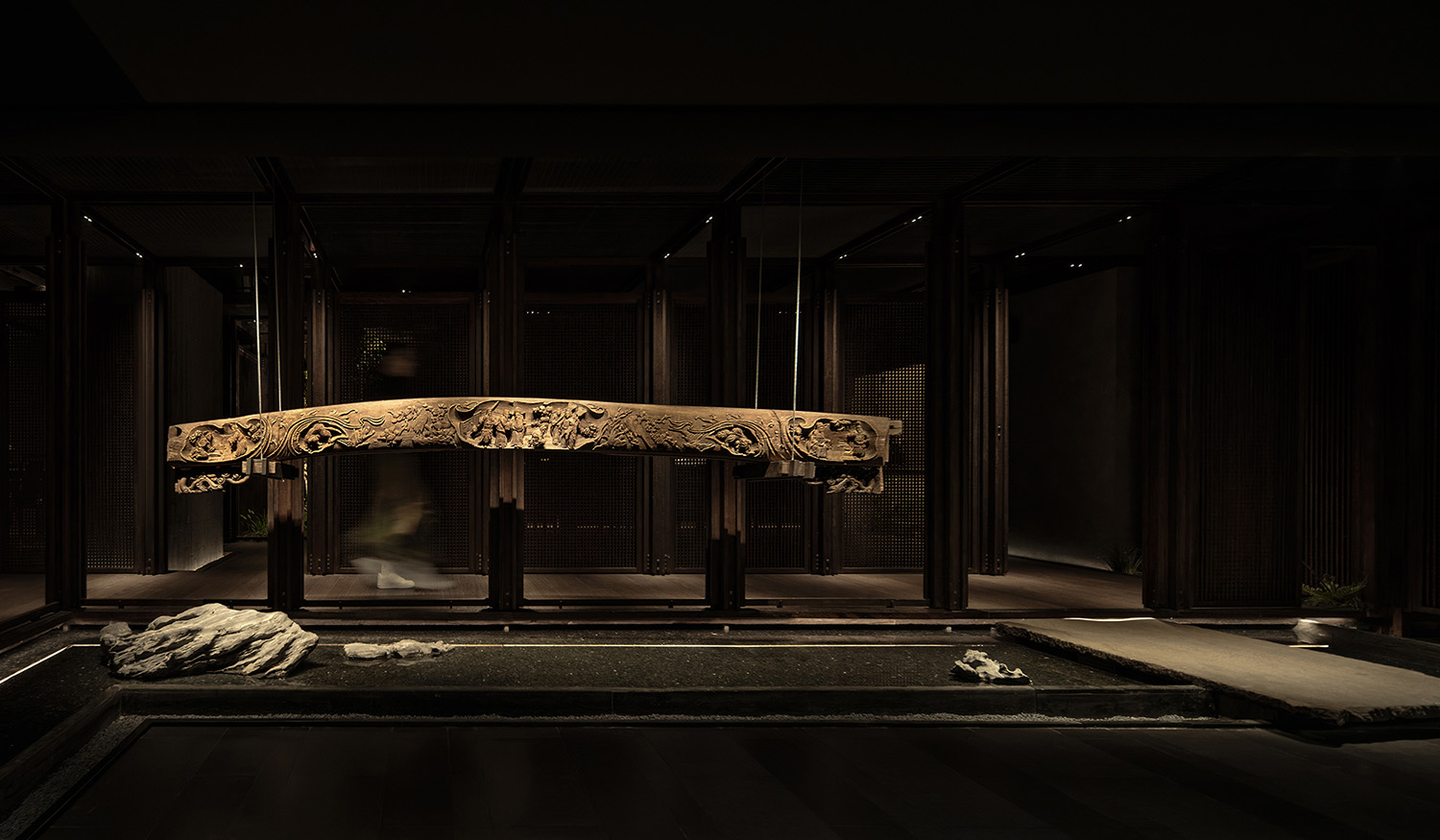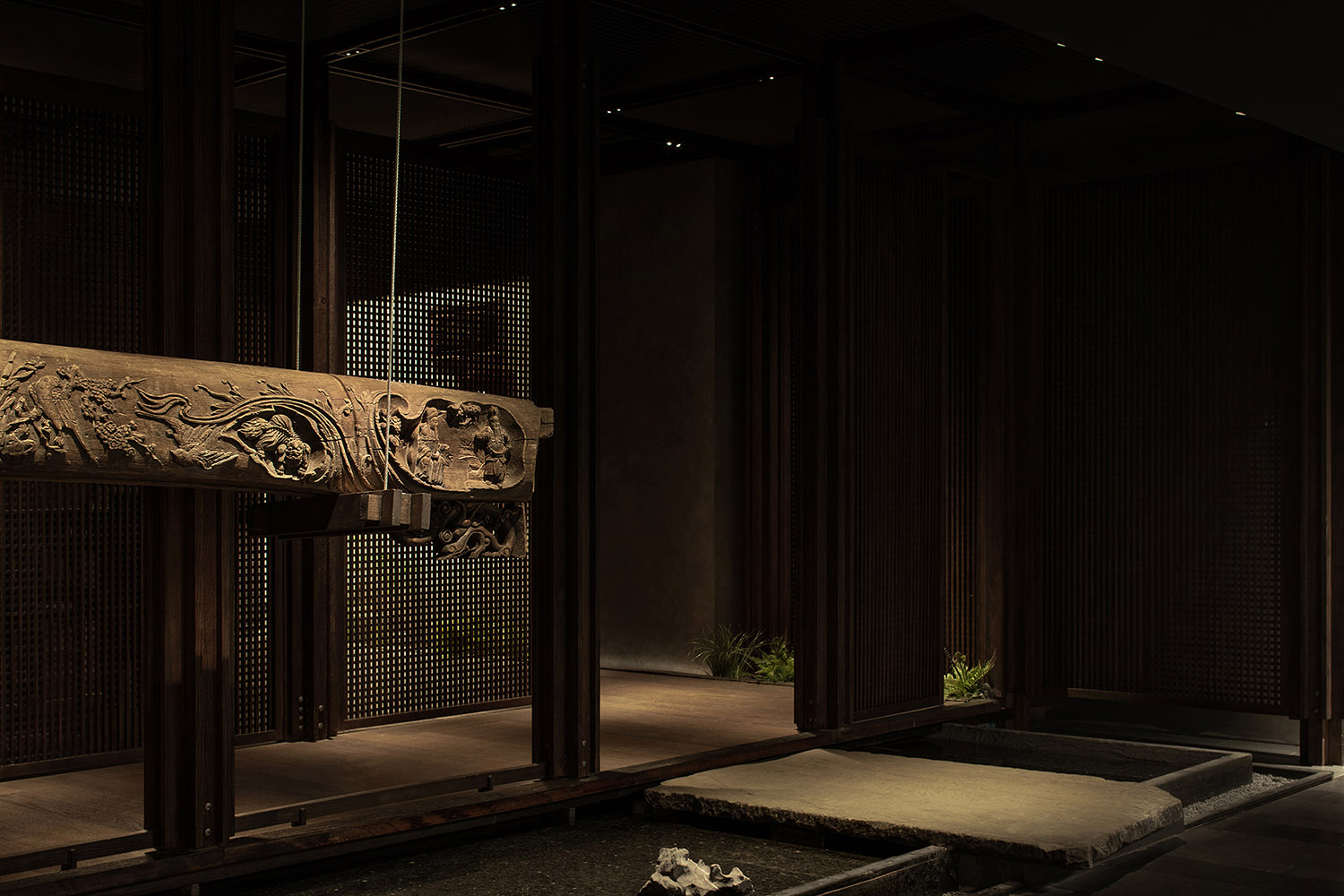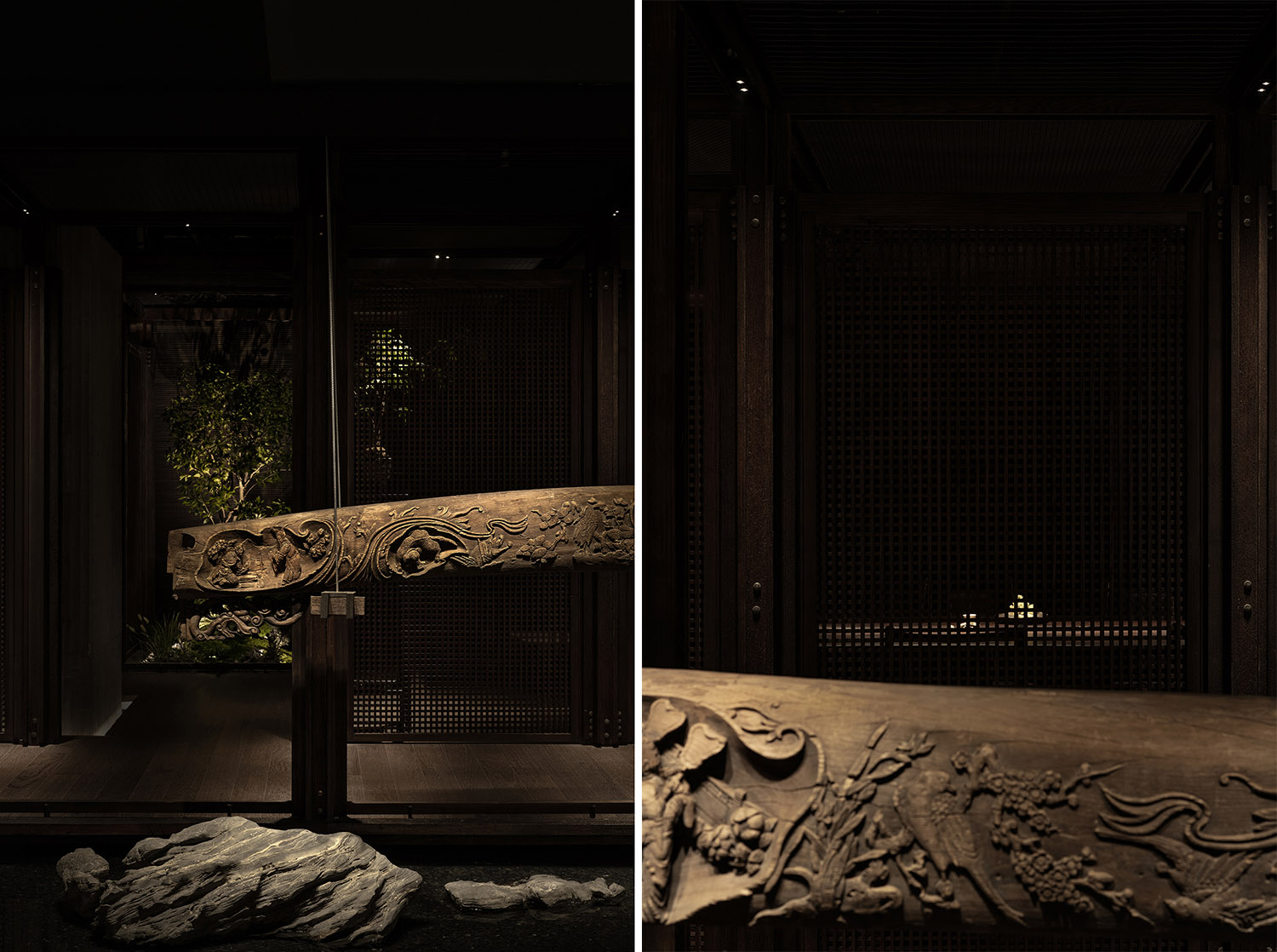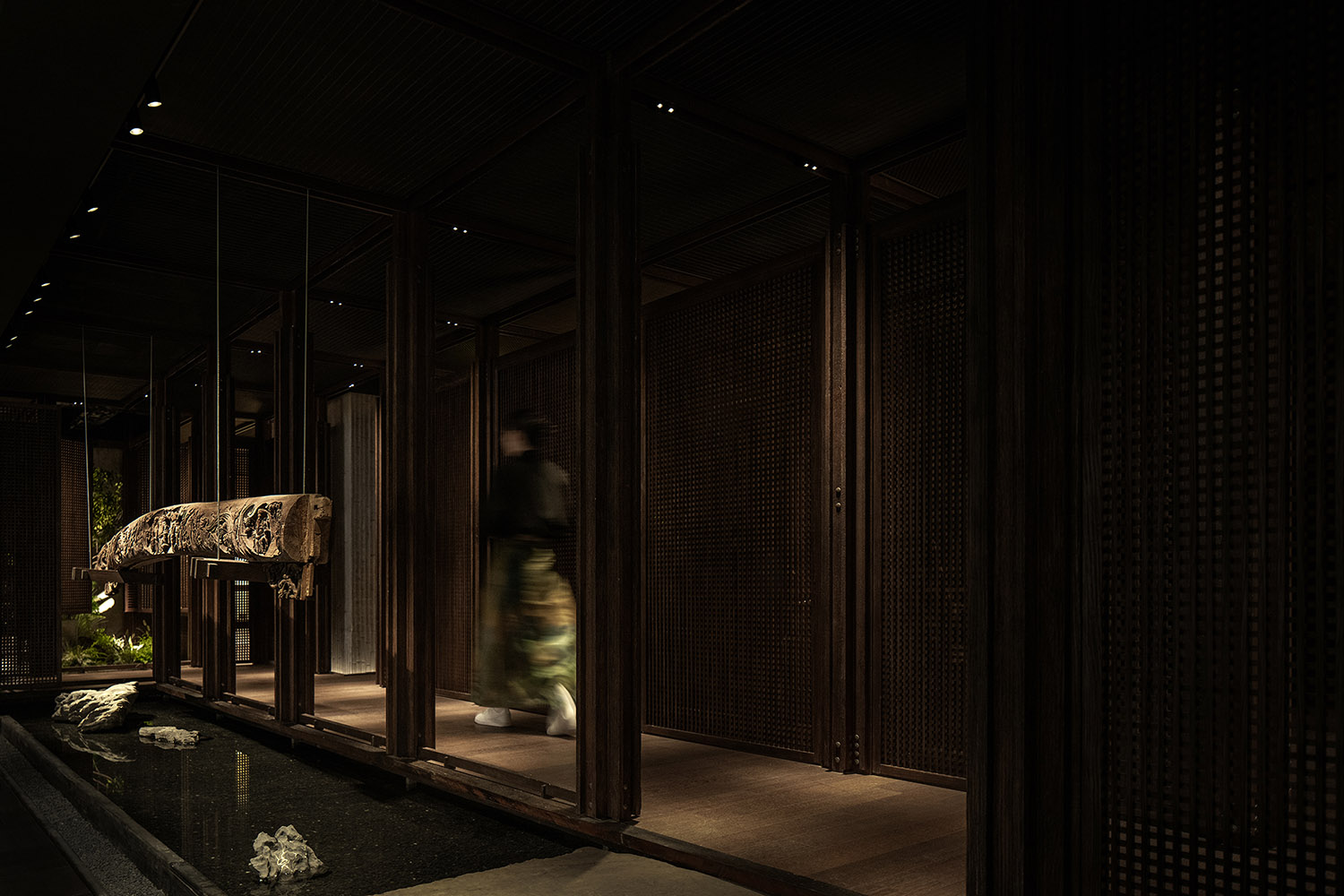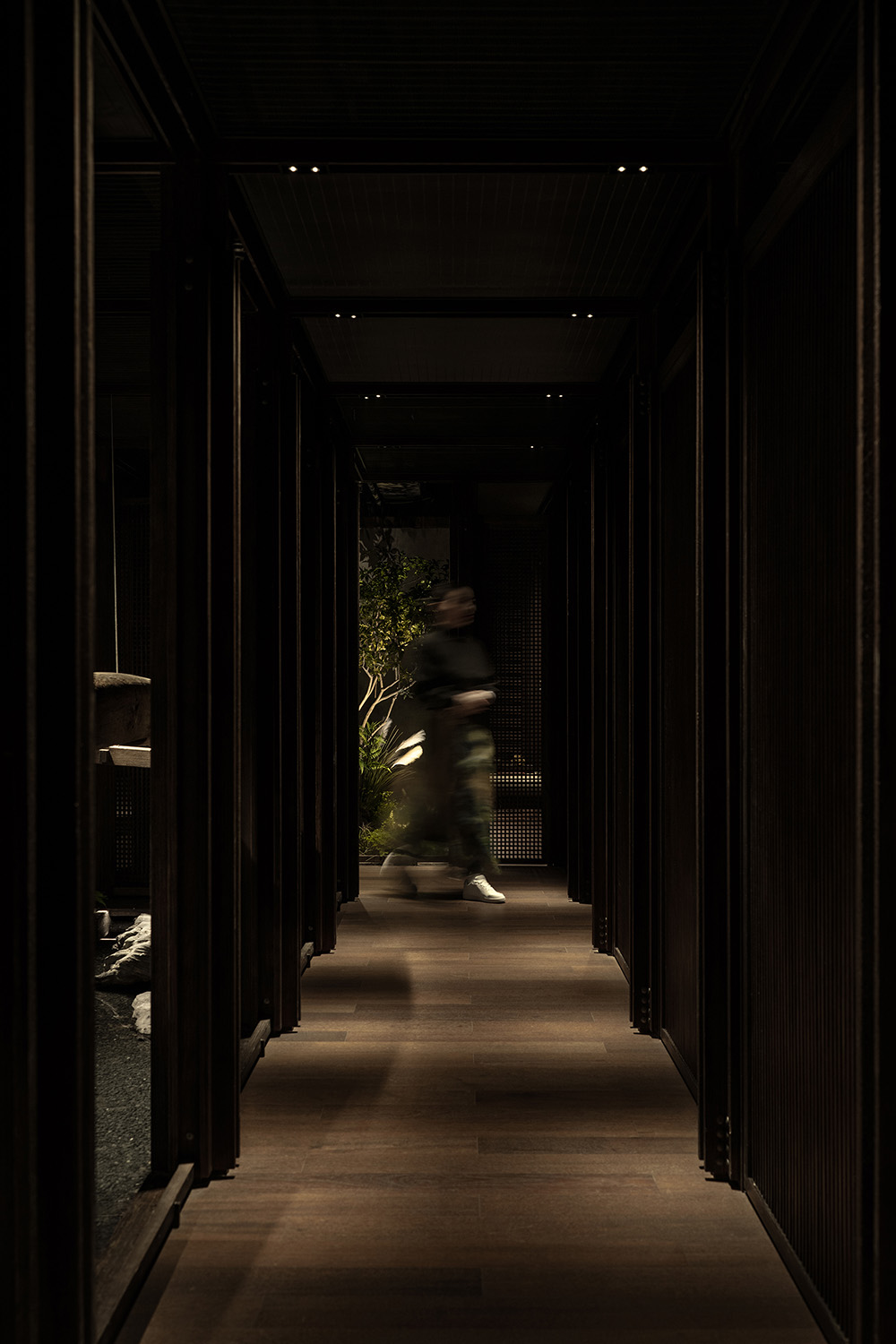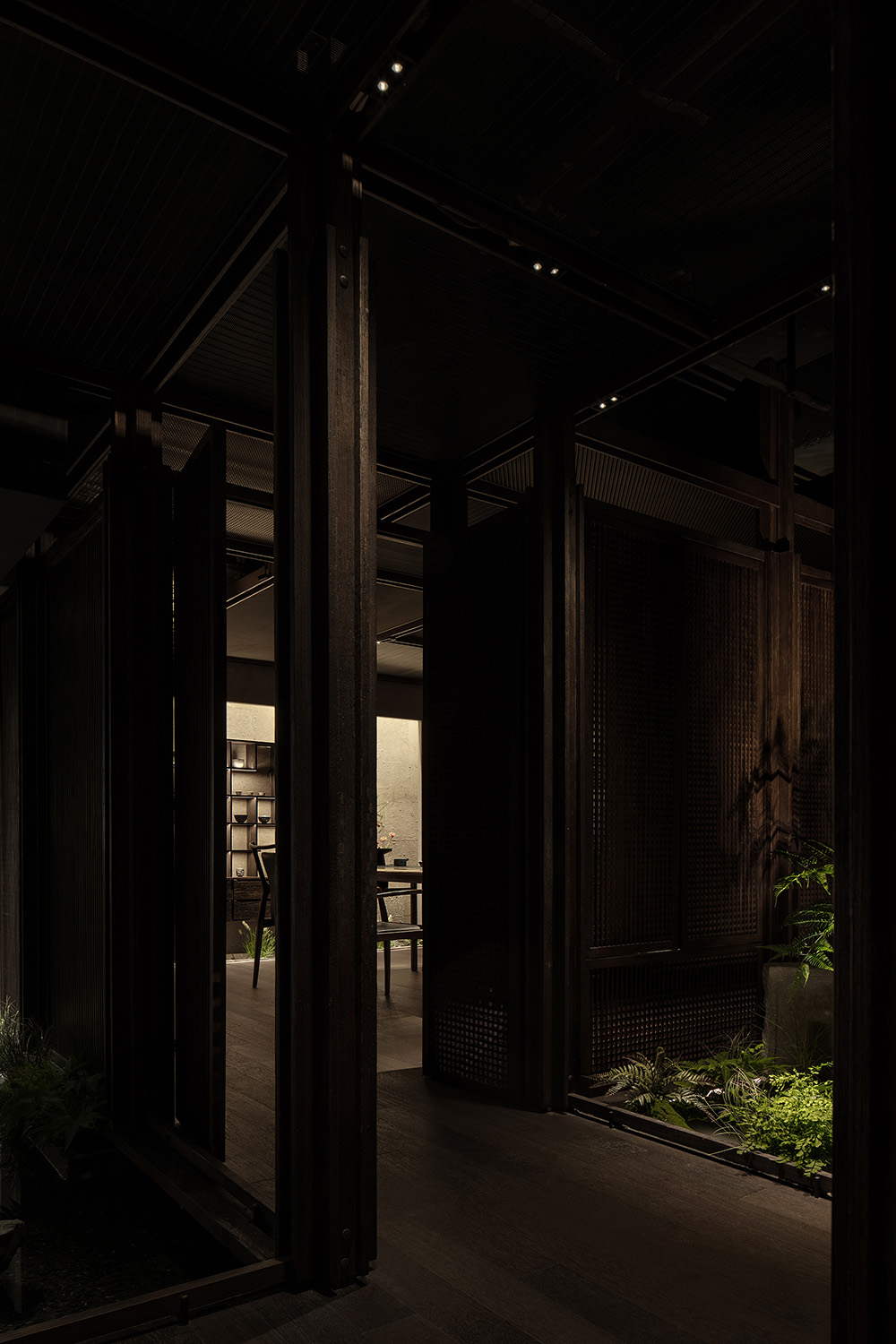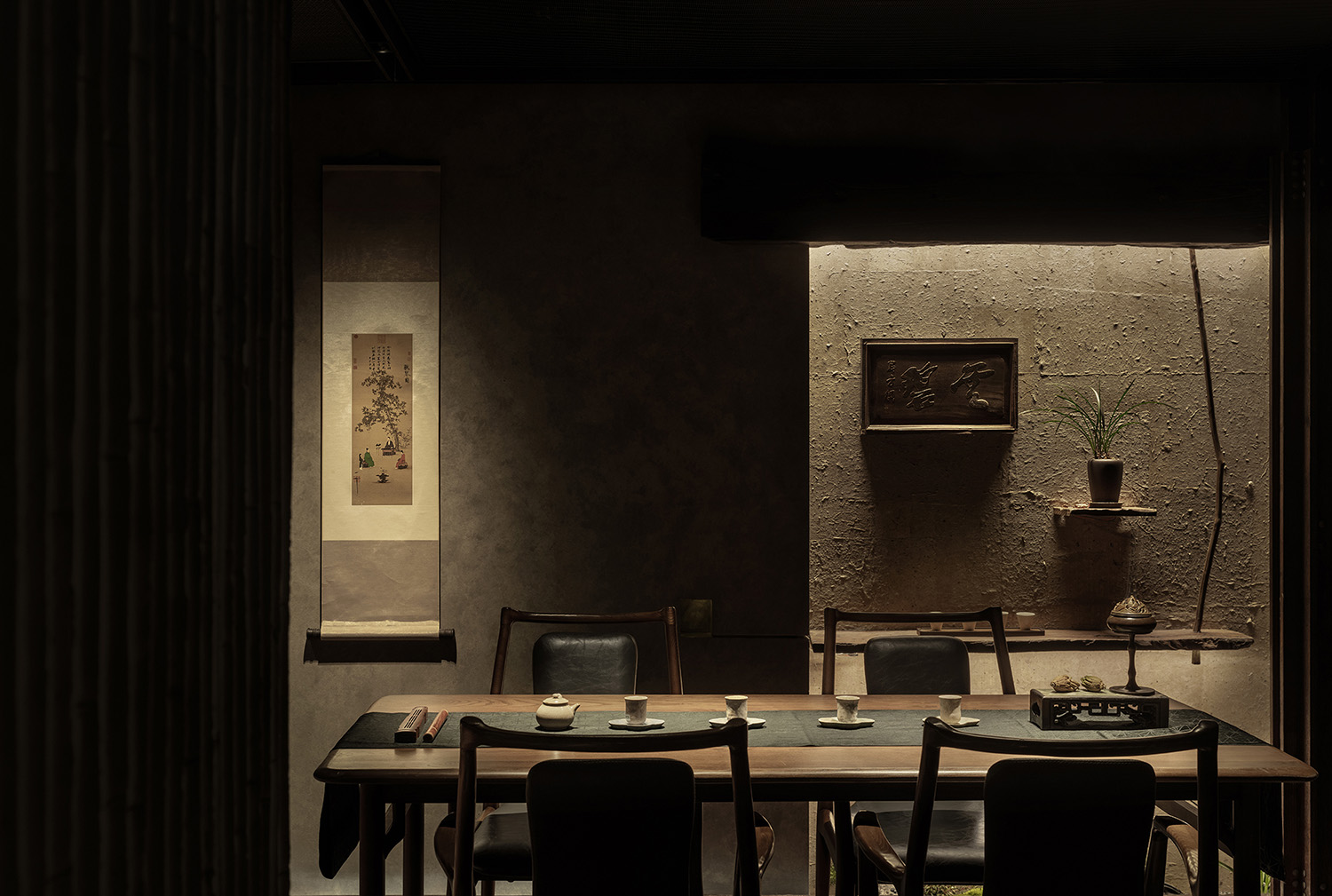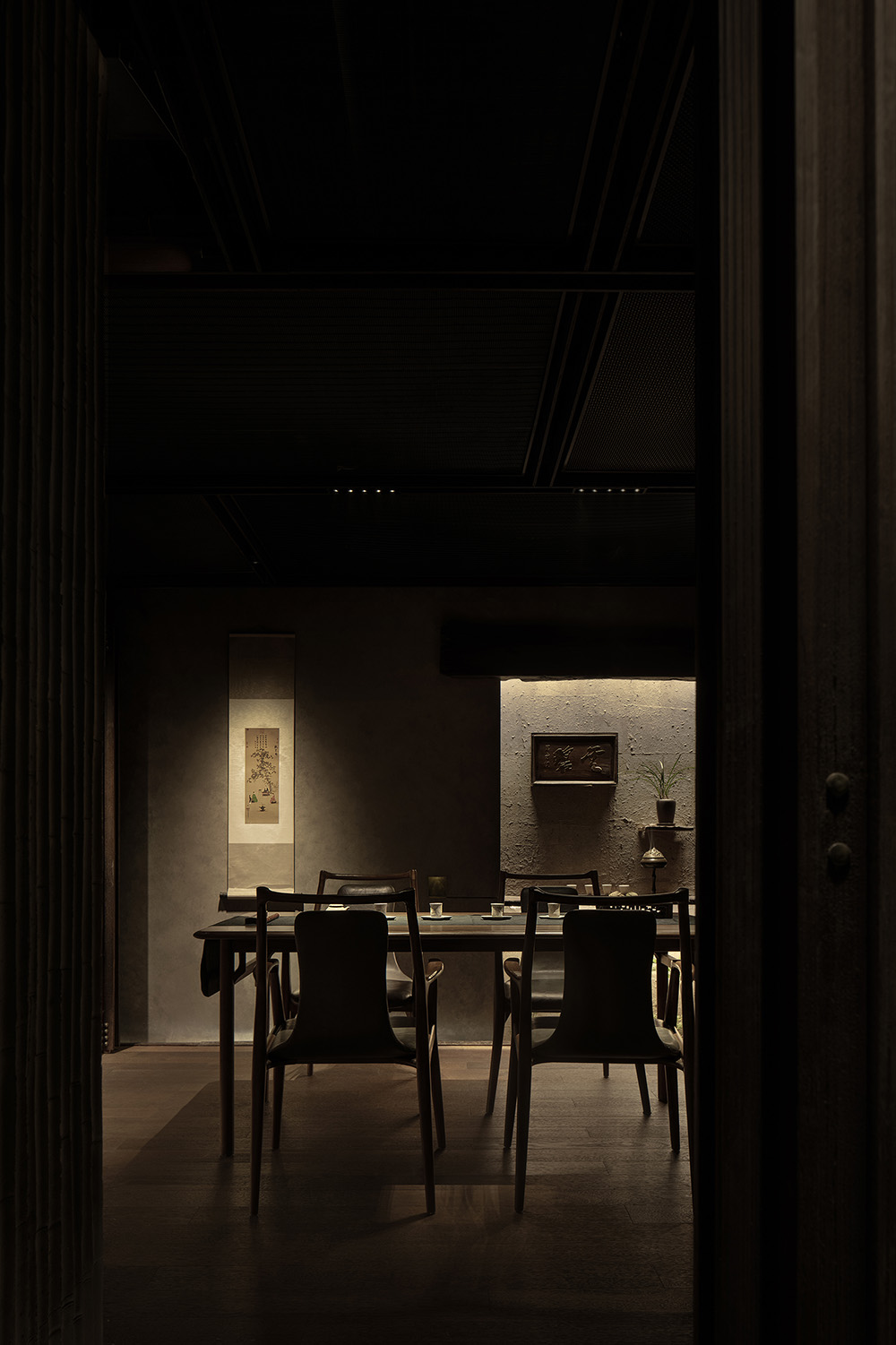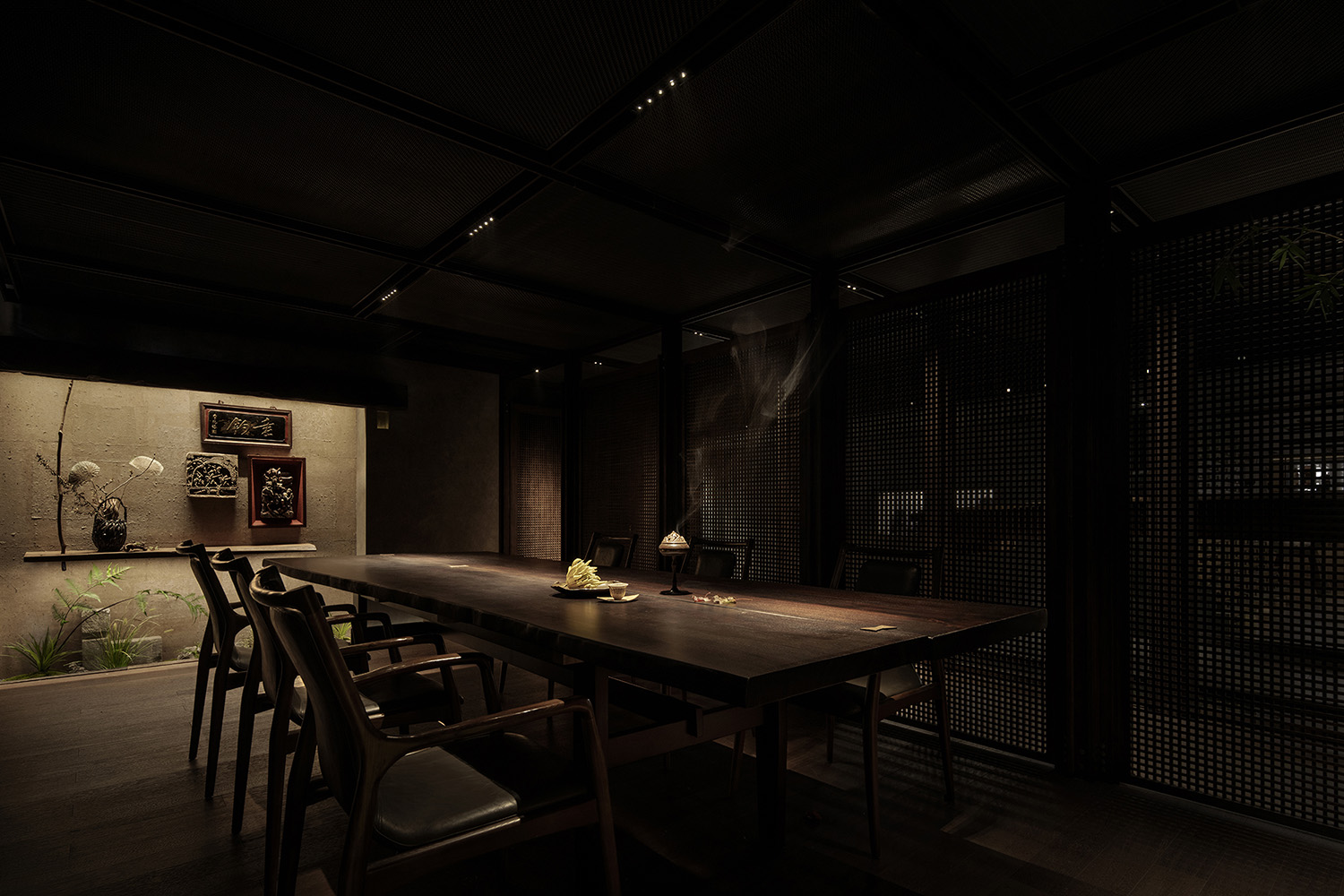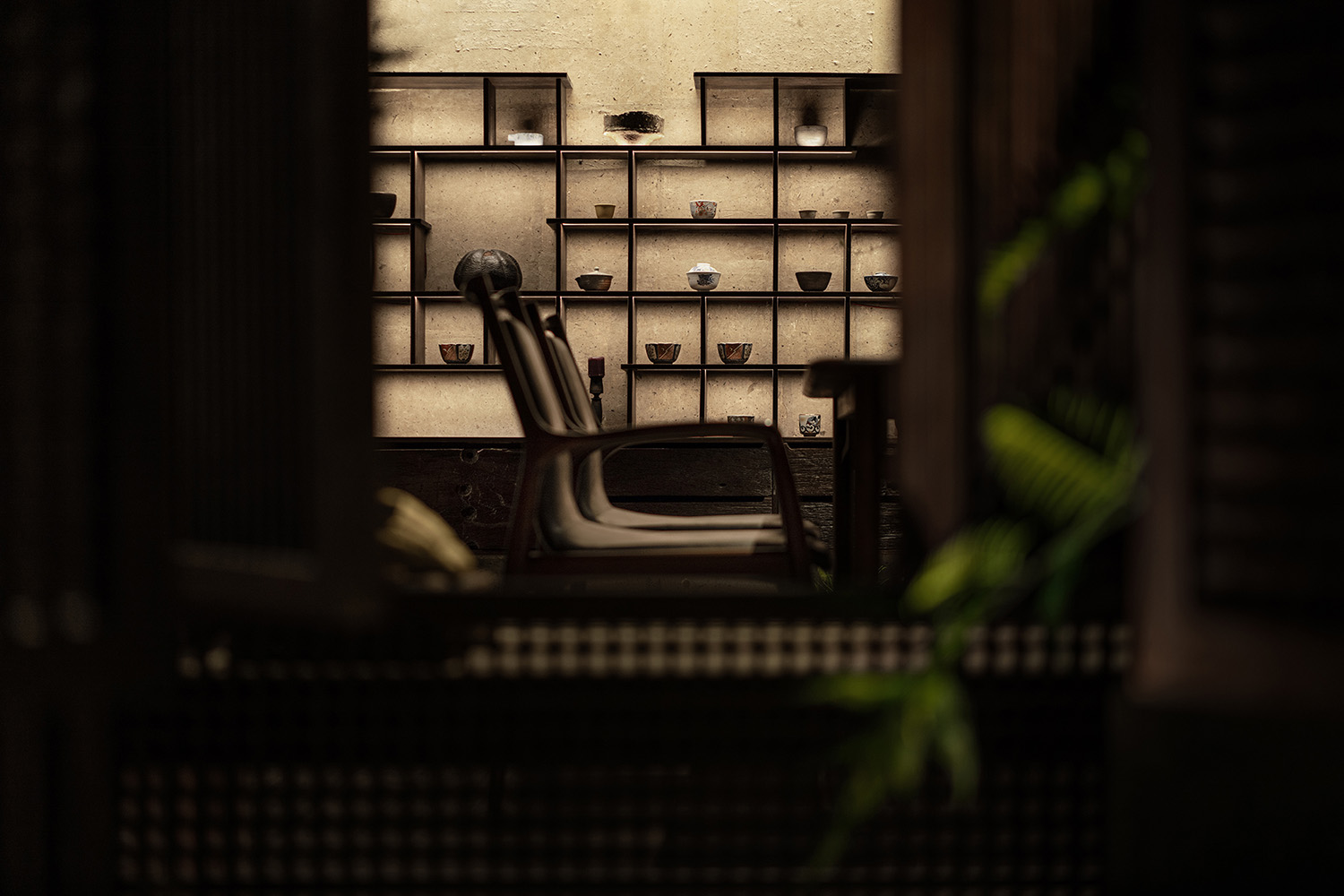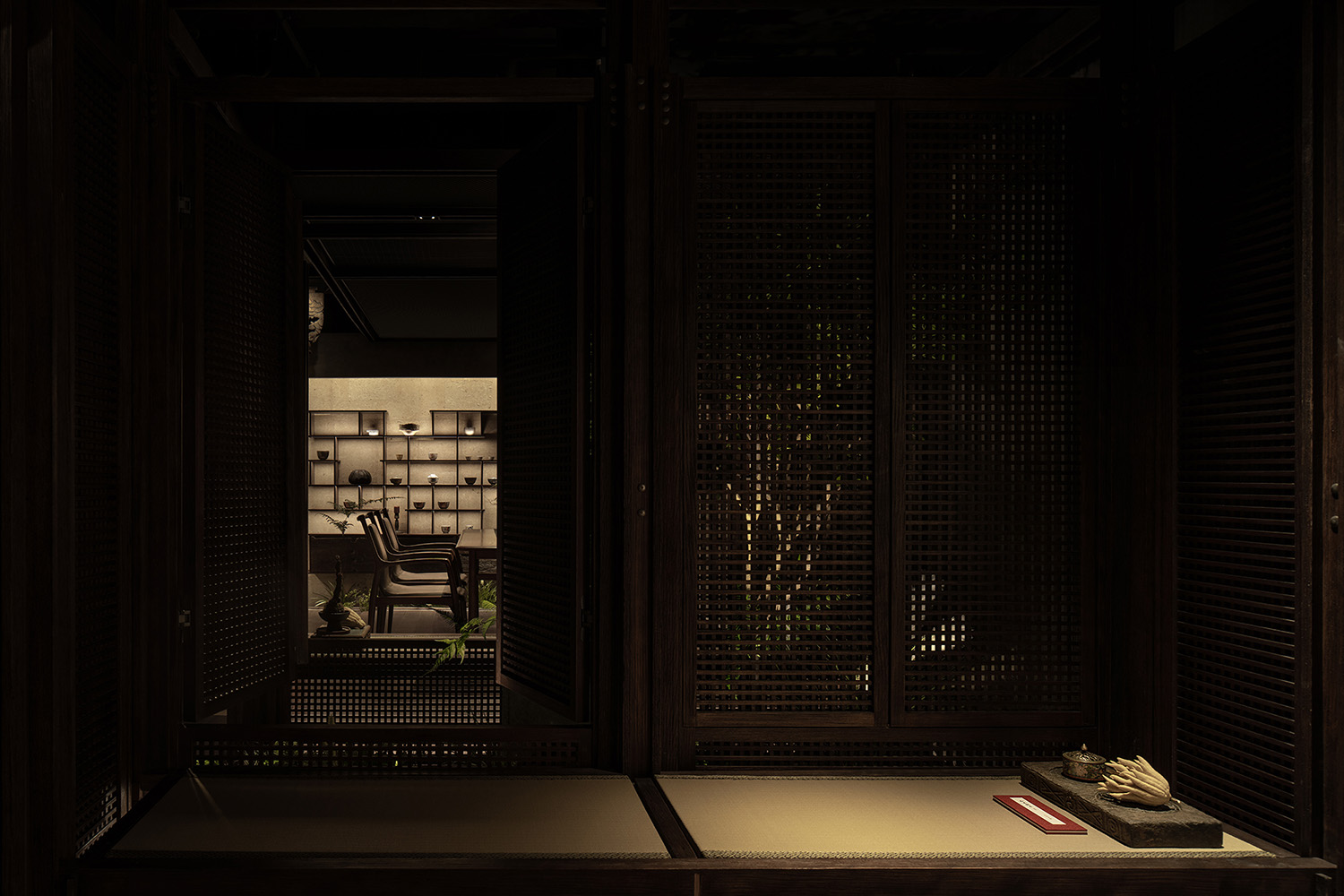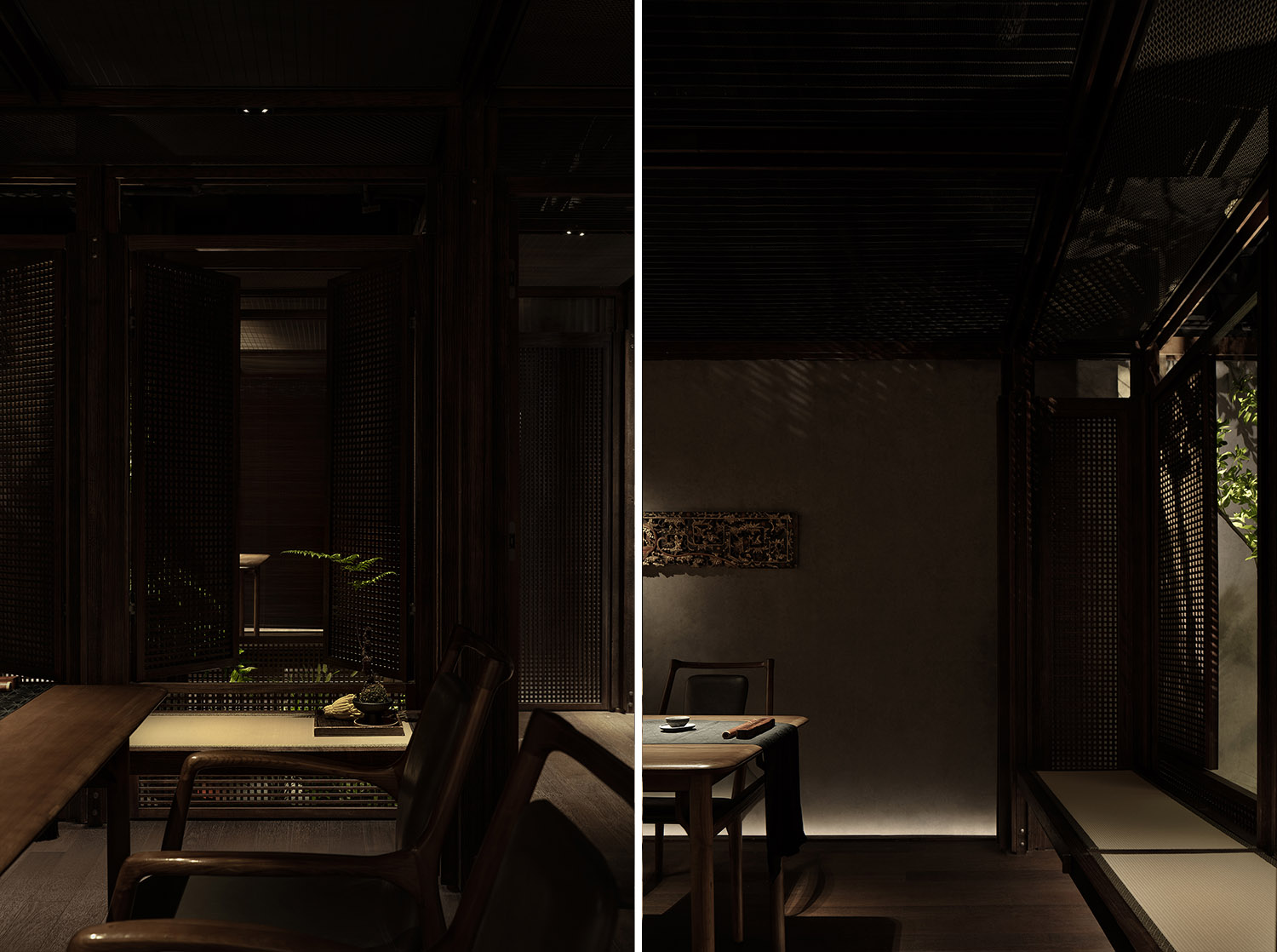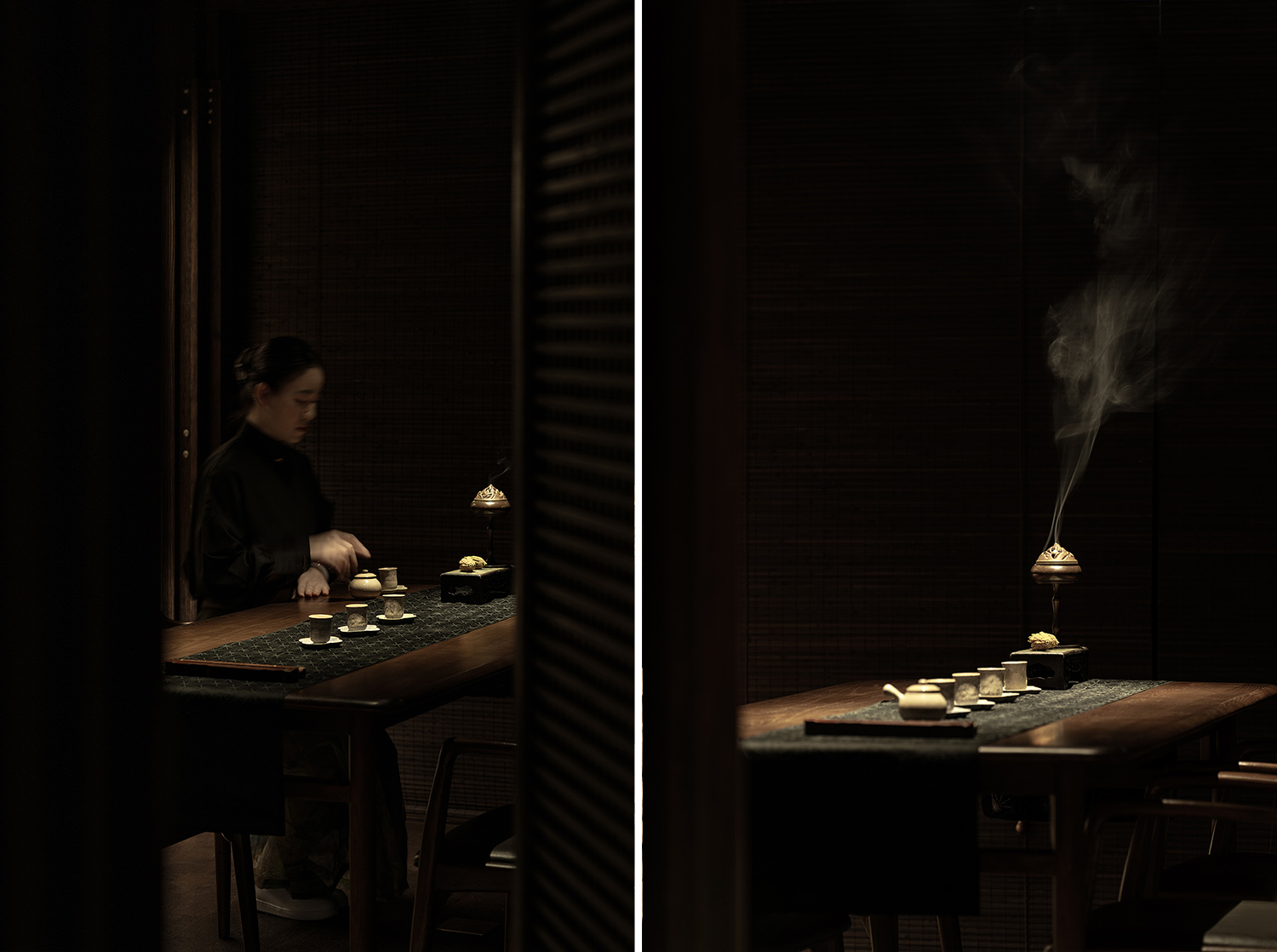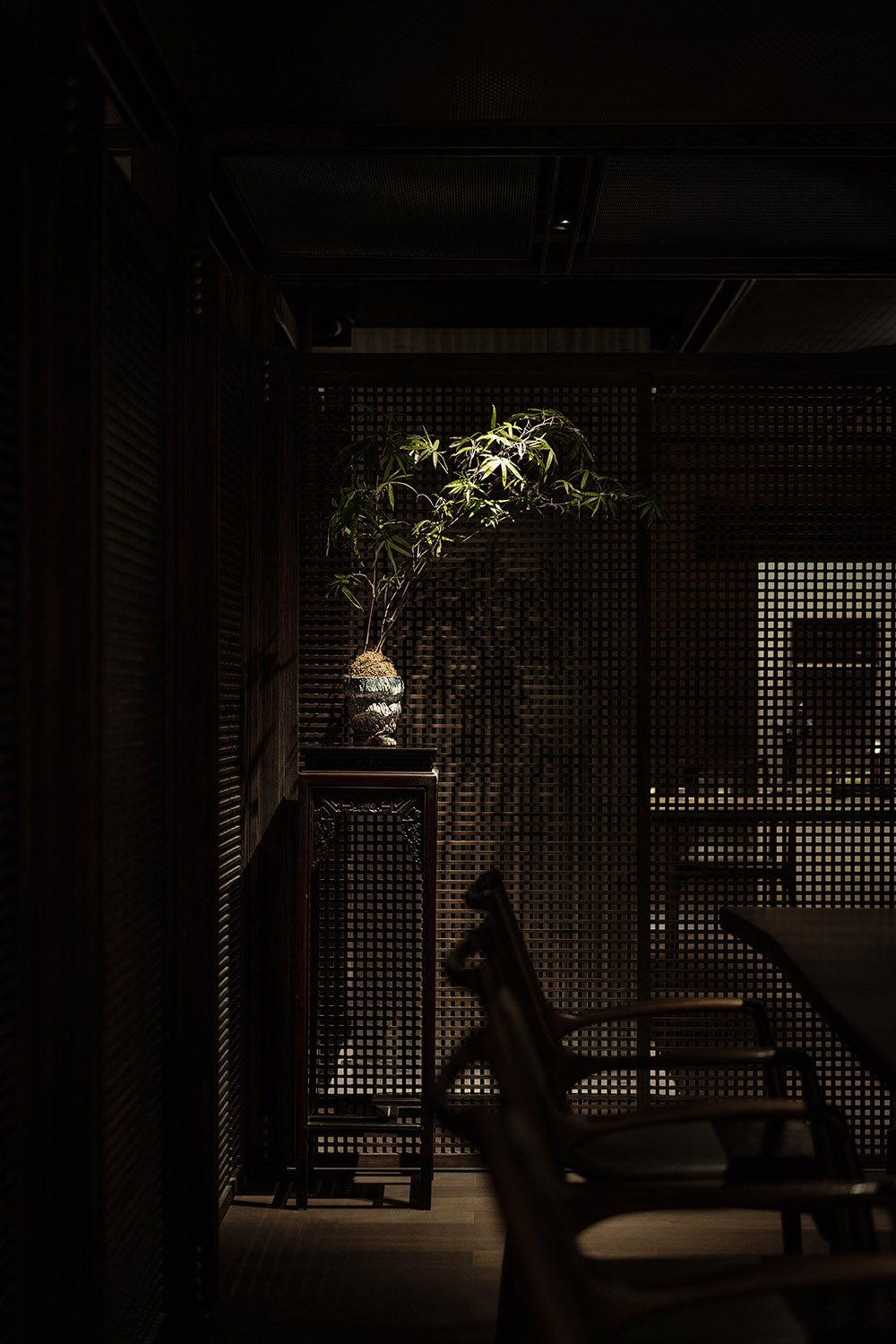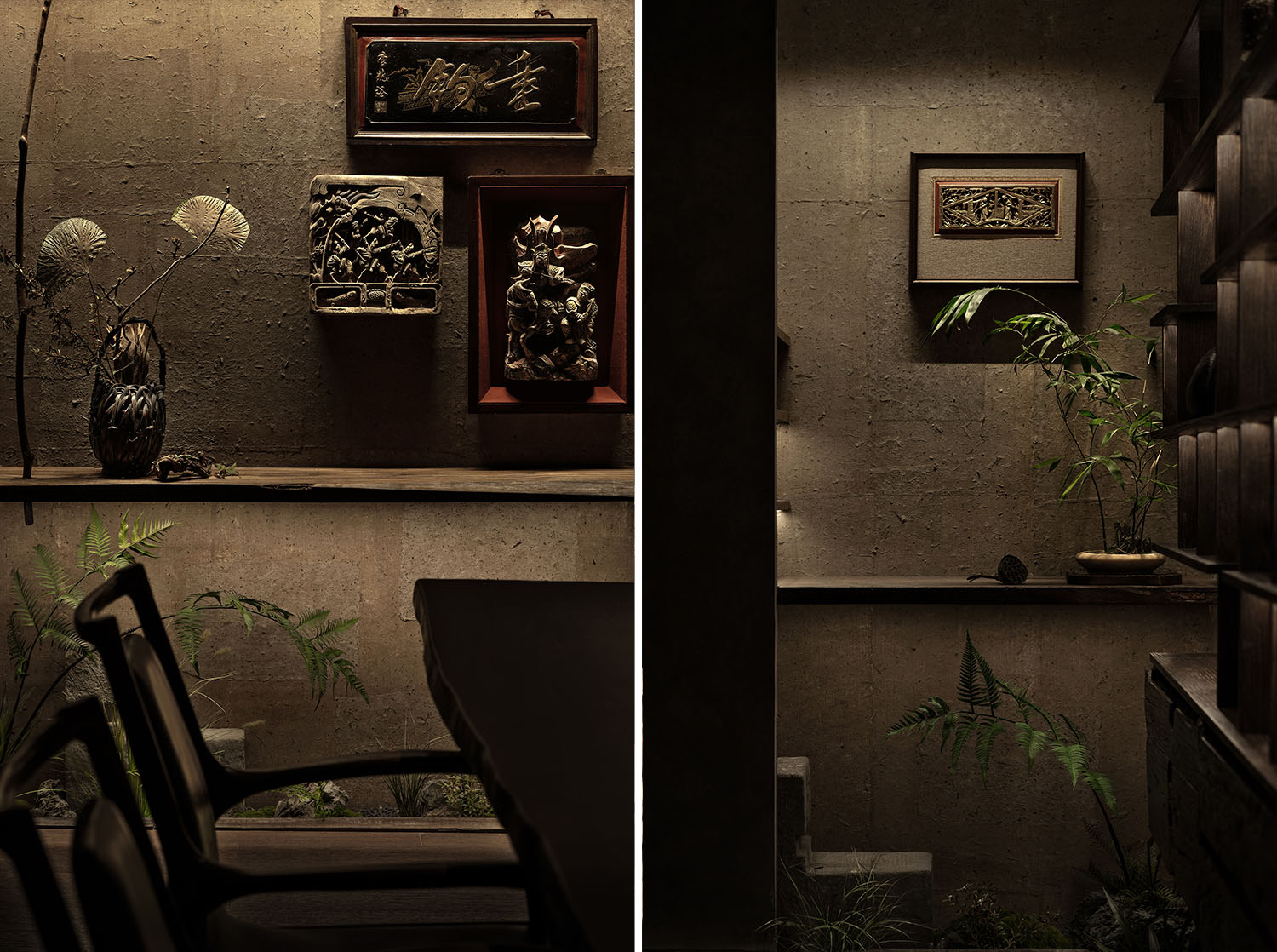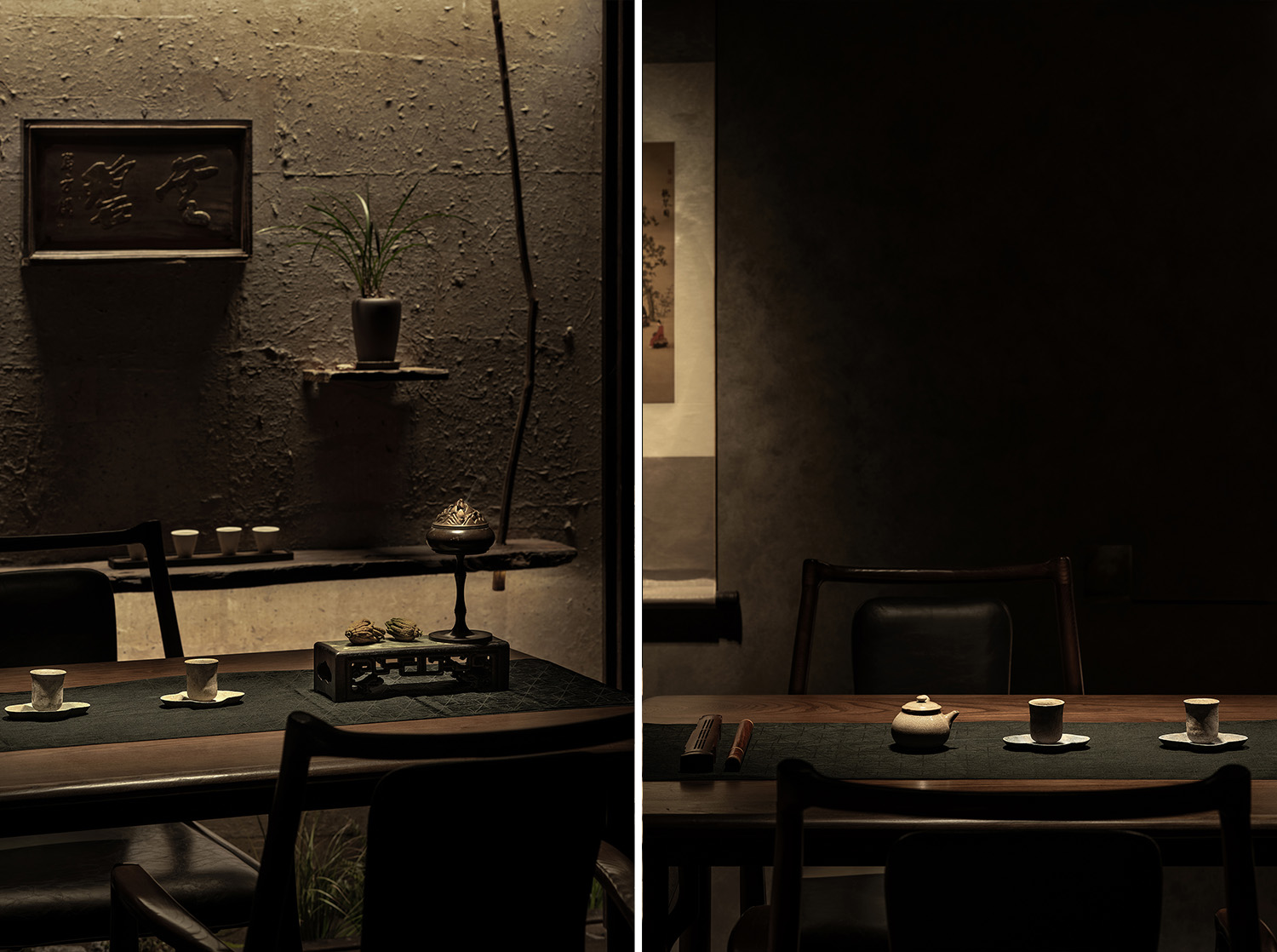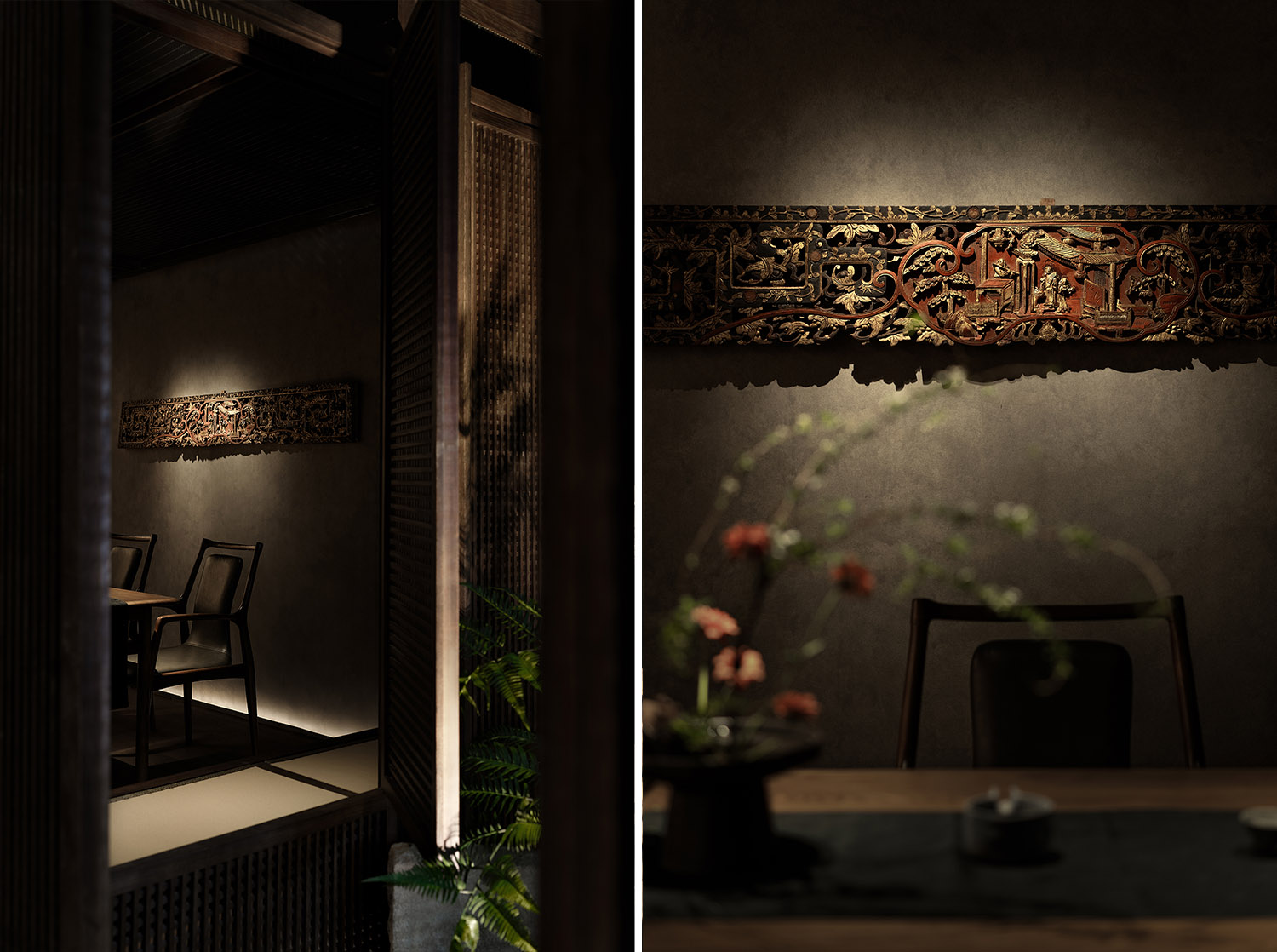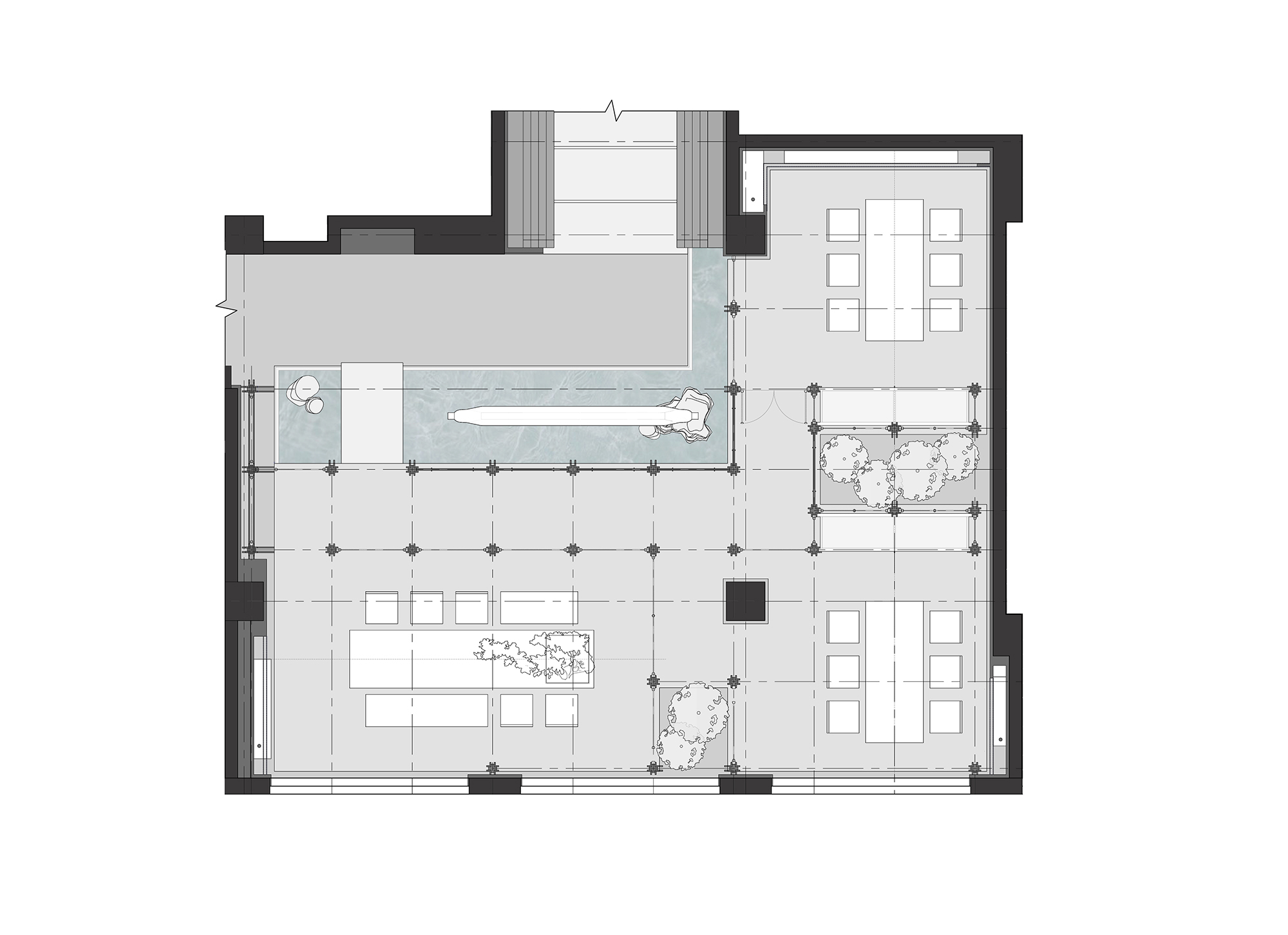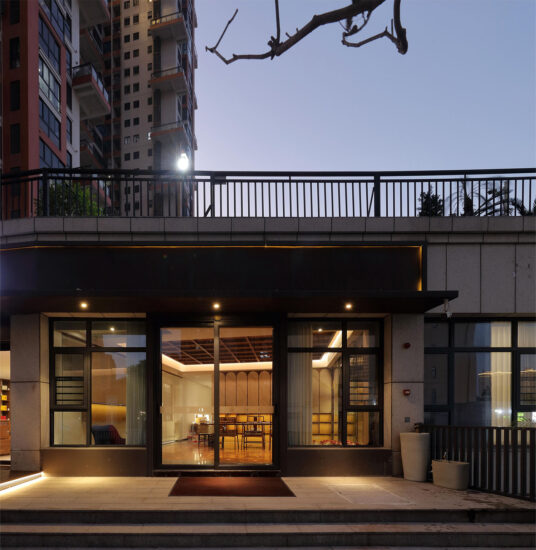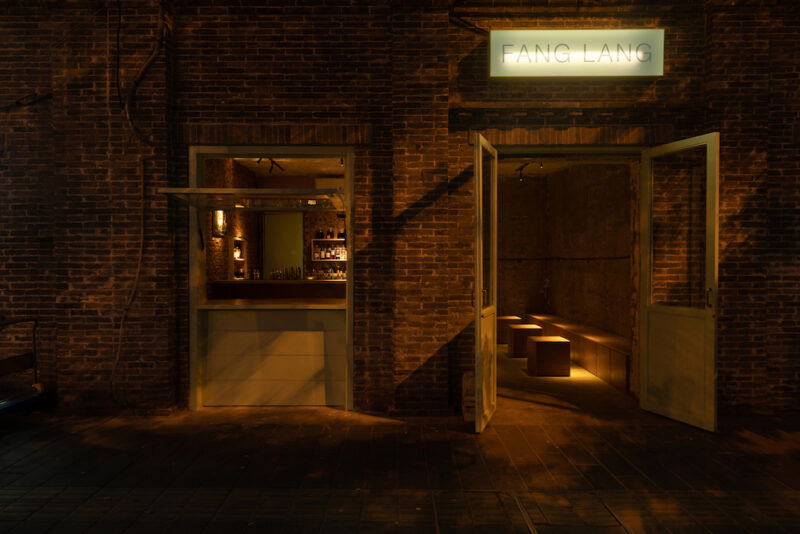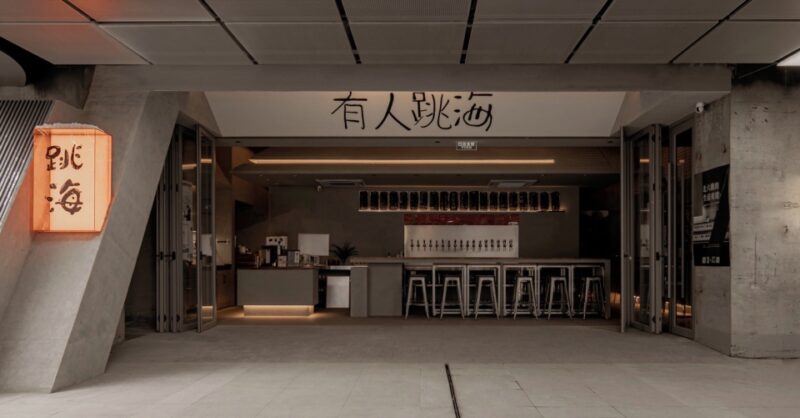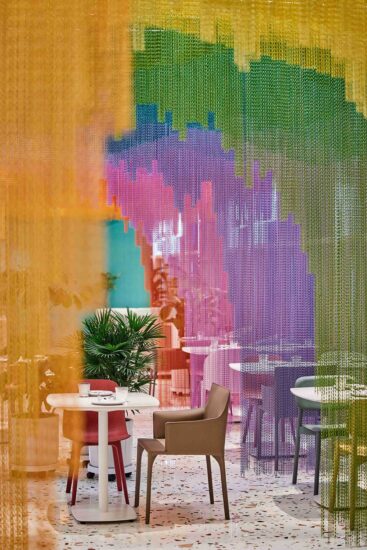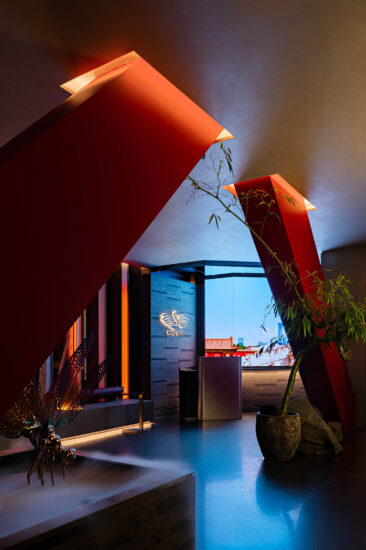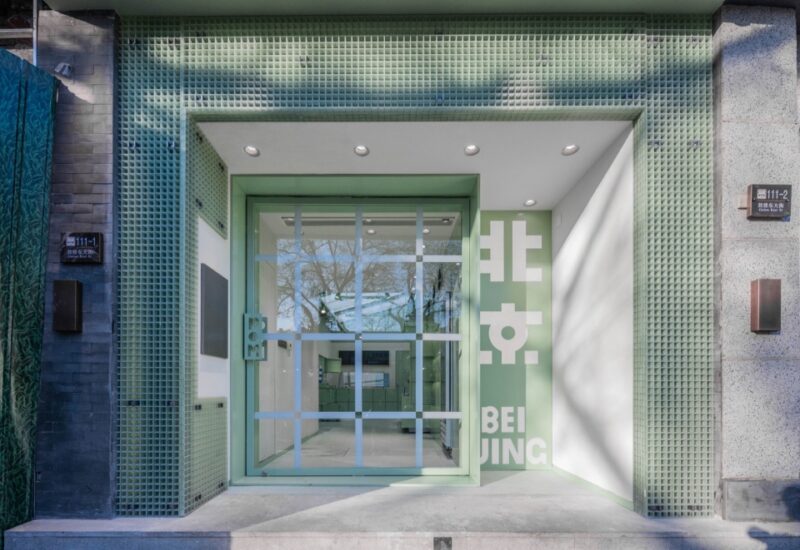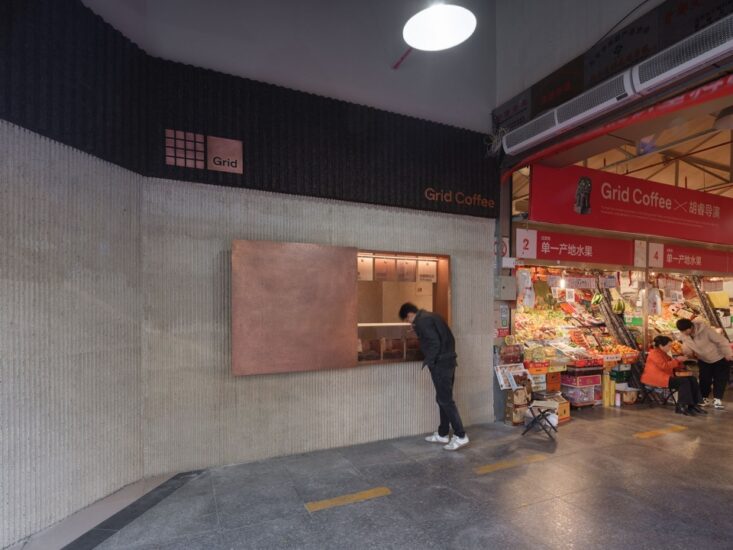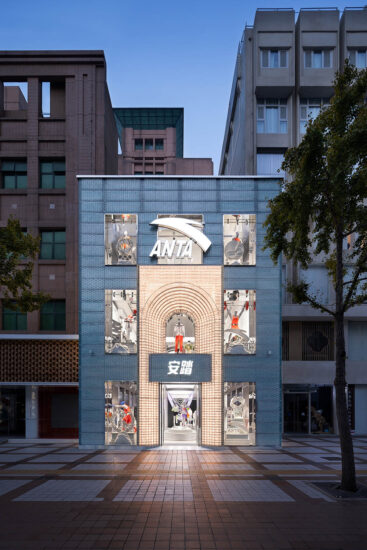『居山水間者為上,村居次之,郊居又次之。吾儕縱不能棲岩止穀,追綺園之蹤,而混跡廛市,要須門庭雅潔,室廬清靚,亭台具曠士之懷,齋閣有幽人之致。』——明·文震亨《長物誌》
Residing amidst mountains and rivers is the foremost choice, followed by village living. Dwelling in the suburbs is deemed the least preferable. Inhabiting in an elegant and pristine home, or a tranquil pavilion, even in a bustling city, mirrors the character of a broad-minded person. The deposition of a secluded individual finds reflection in their living environment.
— Treatise on Superfluous Things by Wen Zhenheng from Ming Dynasty
取源古籍《長物誌》中所載場景,崇尚古、雅、隱,於一園茶室轉述中國傳統文人的雅致生活與和審美意趣。茶之外,物之內,品味生活的閑情逸致。
Inspired by the ancient book “Changwuzhi”, also known as the Treatise on Superfluous Things, this tea space embodies the essence of antiquity, elegance, and seclusion. It conveys traditional Chinese literati’s sophisticated lifestyle and aesthetic sensibilities, while offering a sanctuary for savoring a leisurely and refined life. The tea space creates a peaceful ambiance, inviting guests to immerse themselves in the art of tea appreciation amidst picturesque surroundings.
和木The Home·神玉店·茶空間以古為新,融合傳統東方美學和建築美學文化,賦以自然、古雅、質樸,乃至一方山野之趣的茶事雅境。
The space combines traditional oriental aesthetics with architectural culture, creating a natural, quaint, and elegant environment for enjoying tea, reminiscent of the pleasure derived from sipping tea amidst idyllic landscapes.
焚香、品茗、雅談,
望疏窗,鑒茶器,靜心神。
Burn incense, sip tea, and engage in a conversation;
Take in the view, admire utensils, and calm the mind.
01 隱園·居山水之妙
Secluded Garden
A Wonderful Experience amidst Mountains and Rivers
『居山水間者為上,村居次之,郊居又次之。』
“Residing amidst mountains and rivers is the foremost choice, followed by village living. Dwelling in the suburbs is deemed the least preferable. ”
初見一池水庭,精心設計一場非常規會麵。當城市生活競速、紛繁,行於山水間,提供了立身處世的另一種選擇。
Upon stepping into the space, visitors are greeted by a serene water garden that creates a tranquil and calming atmosphere, perfect for meetings and gatherings. It offers a retreat secluded from the hustle and bustle of urban life, immersing guests in a distinct lifestyle amid mountains and rivers.
一條清代冬瓜梁,抽離於古代建築的梁柱骨架,伴以溫潤太湖石,成為空間的焦點,無聲地對話著北京城的雍雅曆史。
Above the water pool is a Qing Dynasty beam, an essential component of ancient building structures, accompanied by stones sourced from Taihu Lake. It serves as the visual focus of the space and silently echoes the profound, extensive history of Beijing.
追光移步換景,通往另一層時空想象。靜謐與光明處,引人寄情山水,曲水流觴,暢敘雅興。
As guests follow the light, the scenery changes with each step, leading to a different realm of time and space that evokes infinite imagination. The serene and luminous surroundings provide an idyllic setting of tranquil mountains and rivers. Guests are invited to indulge in the winding water features and engage in delightful conversations while enjoying a leisurely sip of tea.
長廊以榫卯相接,滲透千年古建智慧。洄遊水畔,意境幽遠,格柵木門相連,虛實掩映間,步入三處品茗茶室。
The long corridor is crafted using traditional mortise and tenon joints, showcasing the wisdom inherent in ancient architecture spanning millennia. The interconnected grill wooden doors near the pool blur reality and imagination, ushering visitors into three different tea rooms.
02 遊賞·觀茶室之雅
Roaming Enjoy Elegant Tea Rooms
『香茗之用,其利最溥,物外高隱,坐語道德,可以清心悅神。』
“Tea, has various benefits as a beverage. It serves as a means for ancient helmets to purify the soul and uplift the spirits.”
材質、肌理之返璞,陳設、器物之雅致,大量的留白與素簡的線條,皆指向靜謐心境的回歸。
The use of natural materials, original textures, elegant furnishings and utensils, along with plenty of unadorned spaces and simple lines, all indicate a return to a state of inner peace.
暖黃光輝克製地引向長物所至之處,身側掛畫、插花、微縮園景之恬淡高雅,眼前茶桌間之往來談笑,靜心體驗人文茶事。
Soft and warm yellow light leads guests towards elegant embellishments, such as the surrounding paintings, flowers, and miniature gardens, creating a serene atmosphere for enjoying the tea ceremony and connecting with others.
『古人製幾榻,雖長短廣狹不齊,置之齋室,必古雅可愛,又坐臥依憑,無不便適。』
The ancients crafted tatami tea tables of varying lengths and widths, all of which were charming and comfortable for sitting, lying, and leaning.
置榻倚於窗畔,看園景花木光影搖曳,相逢感官的悸動。周身素雅淡然,而清心閑適。
As one leans on the tatami tea table by the window, the swaying shadows of the flowers and trees in the garden come into view, awakening all human senses in the embrace of such an elegant ambiance, creating a calm and relaxed state of mind.
“靜覺眼根無俗物,翛然一室自焚香。”縷縷茶香悠遠,時光如駐,沉浸其中,品鑒幽暗與含蓄的美學。
Without any kitsch, the tea room is enveloped in soothing incense that complements the aroma of tea, offering an immersive appreciation of the dim and implicit oriental aesthetic.
03 雅集·察器物之美
Art Collection
Admire Beautiful Artworks
『又當種佳木怪籜,陳金石圖書,令居之者忘老,寓之者忘歸,遊之者忘倦。』
“The unique plants, carvings, calligraphy works and paintings in a living environment can make the dwellers forget their age, guests reluctant to leave, and visitors shed their fatigue.”
素色為基底,質樸雅致的木質家具、明清時代的雕塑、文人墨客的掛畫,沉澱品茶、參禪、感悟人生的場所。
The space features a subdued palette, complemented by elegant wooden furniture, sculptures from Ming and Qing dynasties and literati paintings. It serves as a haven for tea tasting, Zen meditation, and contemplation of life.
淡雅疏葉,沁入山野氣息。茶器擇古樸之韻,器身富有肌理,展露歲月的痕跡。為茶事增添古意與雅致,窺得古人茶事之樂。
The sparse leaves and textured tea utensils add a natural wild atmosphere and quaint elegance to the tea ceremony, offering a glimpse into ancient people’s affection for tea.
空間沒有繁複的設計,力求以極簡的陳設,反哺以心靈的寧靜。古時雕梁畫棟,輔以做舊牆麵,如藝術品般展呈於眼前。
Without complicated design interventions, the space features minimalist furnishings to nourish the soul, where the carved beams and antique walls appear like pieces of artwork.
推窗見雅事,莫妙於相互借景,透景。以仿舊木材榫卯相接為格柵圍擋,隔而不斷。視線遠近,穿梭古今,層次遞進東方美學意境。
The windows frame beautiful views through landscaping techniques such as view borrowing and penetrating scenery. The grills, which are made using mortise and tenon joints, offer both a continuous and disconnected view. The sight extends from far to near, taking guests through the past and present, and gradually unveiling the beauty of the oriental aesthetic conception.
“戶庭無塵雜,虛室有餘閑。久在樊籠裏,複得返自然。”
“My house escapes from worldly moil or gloom, while ease and quiet permeate my private room. When I escape from bitter strife with men, I live a free and easy life again.”
傳統東方美學意識,與時代人文重逢。在茶香中回歸東方詩意原點,尋得靜謐內觀之境。
In this tea space, the traditional Eastern aesthetic converges with contemporary humanity, capturing the essence of the Oriental poetry and inviting meditation and introspection amidst the aroma of tea.
∇ 總平麵圖 © 棟三尺設計 Plan © DSC·Design
項目信息
項目名稱|和木私廚The Home·神玉店·茶空間
項目地點|北京市西城區
項目麵積|94m²
完工時間|2023.10
業主單位|北京京宴和木餐飲有限公司
設計公司|北京棟三尺設計有限公司
主創設計|李子兆
空間設計|趙誌遠、楊楠
軟裝設計|高可心、魯帥
燈光顧問|朱海燕
施工單位|北京眾象載德建築裝飾工程有限公司
項目攝影|維穀視覺藝術 鍾子鳴
Project name: The Home Tea Space (Shenyu Museum)
Project location: Xicheng District, Beijing
Area: 94 m²
Completion time: October 2023
Client: Beijing Jingyan Hemu Catering Co., Ltd.
Design firm: DSC·Design
Chief designer: Li Zizhao
Design team: Zhao Zhiyuan, Yang Nan
Soft furnishings design: Gao Kexin, Lu Shuai
Lighting consultant: Zhu Haiyan
Construction firm: Beijing Zhongxiang Zaide Architectural Decoration Engineering Co., Ltd.
Photography: Valley Vision/Zhong Ziming


